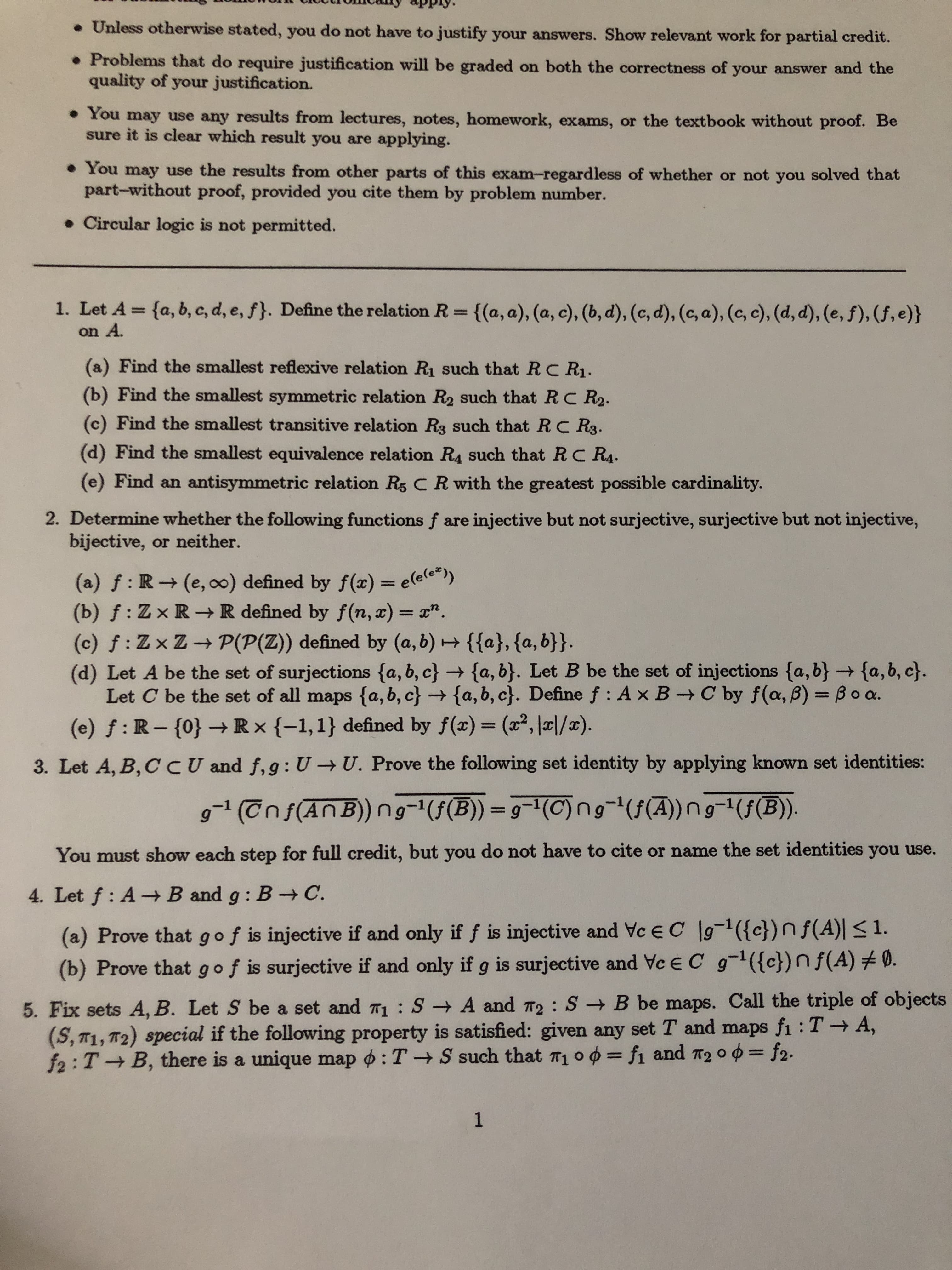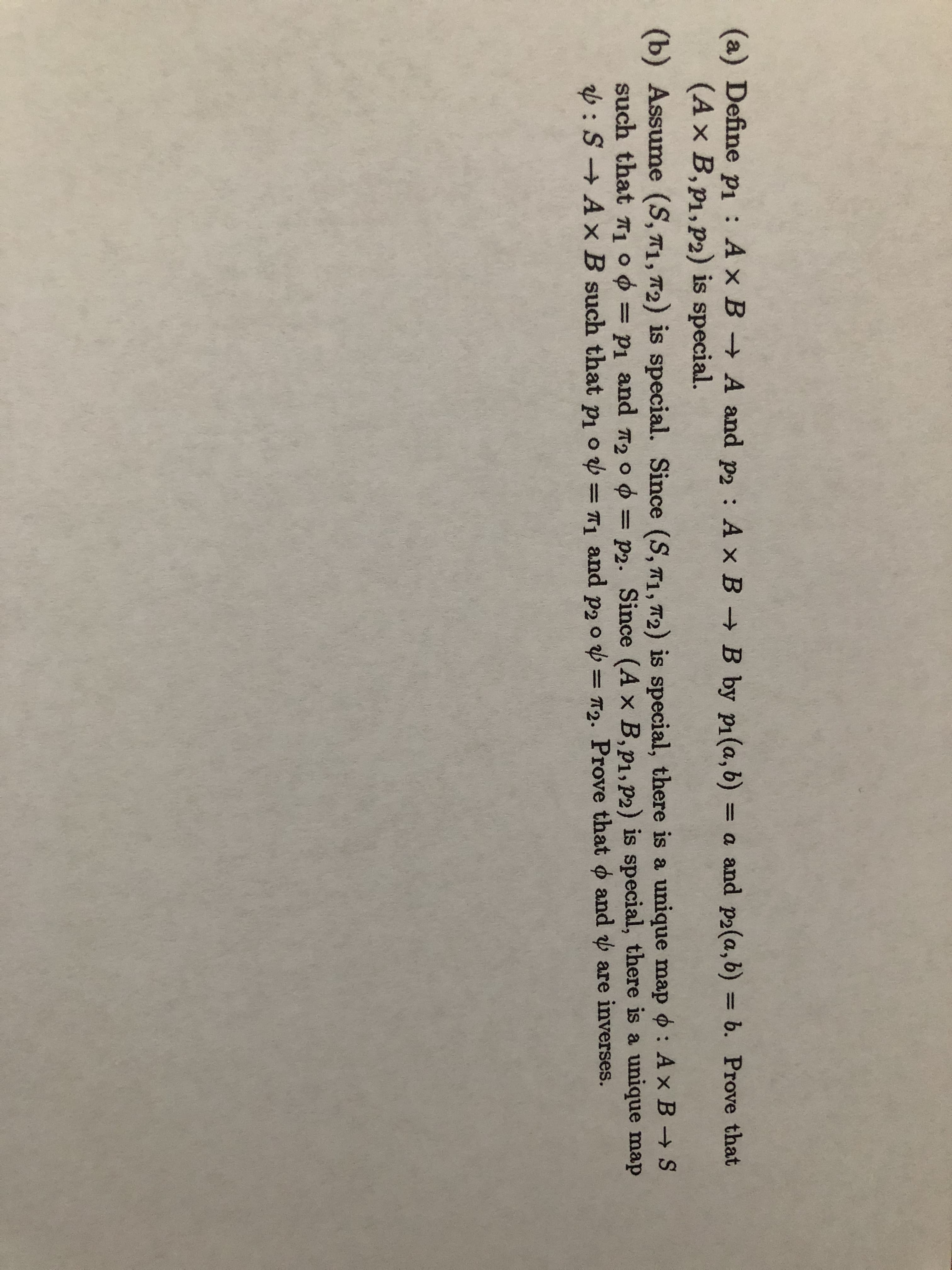• Unless otherwise stated, you do not have to justify your answers. Show relevant work for partial credit. • Problems that do require justification will be graded on both the correctness of your answer and the quality of your justification. • You may use any results from lectures, notes, homework, exams, or the textbook without proof. Be sure it is clear which result you are applying. • You may use the results from other parts of this exam-regardless of whether or not you solved that part-without proof, provided you cite them by problem number. • Circular logic is not permitted. 1. Let A = {a, b, c, d, e, f}. Define the relation R= {(a, a), (a, c), (b, d), (c, d), (c, a), (c, c), (d, d), (e, f), (f, e)} %3D on A. (a) Find the smallest reflexive relation R such that R C R1. (b) Find the smallest symmetric relation R2 such that RC R2. (c) Find the smallest transitive relation R3 such that R C R3. (d) Find the smallest equivalence relation R4 such that RC R4. (e) Find an antisymmetric relation R5 C R with the greatest possible cardinality. 2. Determine whether the following functions f are injective but not surjective, surjective but not injective, bijective, or neither. (a) f: R (e, o0) defined by f(x) = e(e(e*)) (b) f: Zx R-→ R defined by f(n, x) = x". (c) f: Zx Z P(P(Z)) defined by (a, b) {{a}, {a, b}}. (d) Let A be the set of surjections {a, b, c} → {a, b}. Let B be the set of injections {a, b} → {a,b, c}. Let C be the set of all maps {a, b, c} → {a, b, c}. Define f : Ax B→ C by f(a, B) = B o a. (e) f : R – {0} Rx {-1,1} defined by f(x)= (x², |¤|/x). %3D %3D %3D 3. Let A, B,CCU and f,g: U → U. Prove the following set identity by applying known set identities: g-1 (Tnf(AnB)) (f(B)) = 9=(C)ng-"(f(A))ng-(f(B). %3D You must show each step for full credit, but you do not have to cite or name the set identities you use. 4. Let f : A-B and g: B C. (a) Prove that g of is injective if and only if f is injective and Vc EC g-1({c})n f(A) < 1. (b) Prove that gof is surjective if and only if g is surjective and Ve E C g-1({c})n f(A) #0. 5. Fix sets A, B. Let S be a set and 71 : S A and T2: S B be maps. Call the triple of objects (S, T1, T2) special if the following property is satisfied: given any set T and maps fi : T A, f2:T B, there is a unique map o : T S such that T1 o 0 = fi and T2 0 0 = f2. (a) Define p : Ax B A and p2 : A x B B by pi(a, b) = a and p2(a,b) = b. Prove that (Ax B,p1,P2) is special. (b) Assume (S, T1, T2) is special. Since (S, T1, 72) is special, there is a unique map o : Ax B S such that Tı ° ¢ = p1 and 720 0 = p2. Since (A x B,p1, P2) is special, there is a unique map v:S → A x B such that pi o = T, and p2 o v = T2. Prove that o and are inverses. %3D %3D
• Unless otherwise stated, you do not have to justify your answers. Show relevant work for partial credit. • Problems that do require justification will be graded on both the correctness of your answer and the quality of your justification. • You may use any results from lectures, notes, homework, exams, or the textbook without proof. Be sure it is clear which result you are applying. • You may use the results from other parts of this exam-regardless of whether or not you solved that part-without proof, provided you cite them by problem number. • Circular logic is not permitted. 1. Let A = {a, b, c, d, e, f}. Define the relation R= {(a, a), (a, c), (b, d), (c, d), (c, a), (c, c), (d, d), (e, f), (f, e)} %3D on A. (a) Find the smallest reflexive relation R such that R C R1. (b) Find the smallest symmetric relation R2 such that RC R2. (c) Find the smallest transitive relation R3 such that R C R3. (d) Find the smallest equivalence relation R4 such that RC R4. (e) Find an antisymmetric relation R5 C R with the greatest possible cardinality. 2. Determine whether the following functions f are injective but not surjective, surjective but not injective, bijective, or neither. (a) f: R (e, o0) defined by f(x) = e(e(e*)) (b) f: Zx R-→ R defined by f(n, x) = x". (c) f: Zx Z P(P(Z)) defined by (a, b) {{a}, {a, b}}. (d) Let A be the set of surjections {a, b, c} → {a, b}. Let B be the set of injections {a, b} → {a,b, c}. Let C be the set of all maps {a, b, c} → {a, b, c}. Define f : Ax B→ C by f(a, B) = B o a. (e) f : R – {0} Rx {-1,1} defined by f(x)= (x², |¤|/x). %3D %3D %3D 3. Let A, B,CCU and f,g: U → U. Prove the following set identity by applying known set identities: g-1 (Tnf(AnB)) (f(B)) = 9=(C)ng-"(f(A))ng-(f(B). %3D You must show each step for full credit, but you do not have to cite or name the set identities you use. 4. Let f : A-B and g: B C. (a) Prove that g of is injective if and only if f is injective and Vc EC g-1({c})n f(A) < 1. (b) Prove that gof is surjective if and only if g is surjective and Ve E C g-1({c})n f(A) #0. 5. Fix sets A, B. Let S be a set and 71 : S A and T2: S B be maps. Call the triple of objects (S, T1, T2) special if the following property is satisfied: given any set T and maps fi : T A, f2:T B, there is a unique map o : T S such that T1 o 0 = fi and T2 0 0 = f2. (a) Define p : Ax B A and p2 : A x B B by pi(a, b) = a and p2(a,b) = b. Prove that (Ax B,p1,P2) is special. (b) Assume (S, T1, T2) is special. Since (S, T1, 72) is special, there is a unique map o : Ax B S such that Tı ° ¢ = p1 and 720 0 = p2. Since (A x B,p1, P2) is special, there is a unique map v:S → A x B such that pi o = T, and p2 o v = T2. Prove that o and are inverses. %3D %3D
Glencoe Algebra 1, Student Edition, 9780079039897, 0079039898, 2018
18th Edition
ISBN:9780079039897
Author:Carter
Publisher:Carter
Chapter3: Linear And Nonlinear Functions
Section3.7: Piecewise And Step Functions
Problem 30PPS
Related questions
Question
Need help with Discrete math, in specific Relations

Transcribed Image Text:• Unless otherwise stated, you do not have to justify your answers. Show relevant work for partial credit.
• Problems that do require justification will be graded on both the correctness of your answer and the
quality of your justification.
• You may use any results from lectures, notes, homework, exams, or the textbook without proof. Be
sure it is clear which result you are applying.
• You may use the results from other parts of this exam-regardless of whether or not you solved that
part-without proof, provided you cite them by problem number.
• Circular logic is not permitted.
1. Let A = {a, b, c, d, e, f}. Define the relation R= {(a, a), (a, c), (b, d), (c, d), (c, a), (c, c), (d, d), (e, f), (f, e)}
%3D
on A.
(a) Find the smallest reflexive relation R such that R C R1.
(b) Find the smallest symmetric relation R2 such that RC R2.
(c) Find the smallest transitive relation R3 such that R C R3.
(d) Find the smallest equivalence relation R4 such that RC R4.
(e) Find an antisymmetric relation R5 C R with the greatest possible cardinality.
2. Determine whether the following functions f are injective but not surjective, surjective but not injective,
bijective, or neither.
(a) f: R (e, o0) defined by f(x) = e(e(e*))
(b) f: Zx R-→ R defined by f(n, x) = x".
(c) f: Zx Z P(P(Z)) defined by (a, b) {{a}, {a, b}}.
(d) Let A be the set of surjections {a, b, c} → {a, b}. Let B be the set of injections {a, b} → {a,b, c}.
Let C be the set of all maps {a, b, c} → {a, b, c}. Define f : Ax B→ C by f(a, B) = B o a.
(e) f : R – {0} Rx {-1,1} defined by f(x)= (x², |¤|/x).
%3D
%3D
%3D
3. Let A, B,CCU and f,g: U → U. Prove the following set identity by applying known set identities:
g-1 (Tnf(AnB)) (f(B)) = 9=(C)ng-"(f(A))ng-(f(B).
%3D
You must show each step for full credit, but you do not have to cite or name the set identities you use.
4. Let f : A-B and g: B C.
(a) Prove that g of is injective if and only if f is injective and Vc EC g-1({c})n f(A) < 1.
(b) Prove that gof is surjective if and only if g is surjective and Ve E C g-1({c})n f(A) #0.
5. Fix sets A, B. Let S be a set and 71 : S A and T2: S B be maps. Call the triple of objects
(S, T1, T2) special if the following property is satisfied: given any set T and maps fi : T A,
f2:T B, there is a unique map o : T S such that T1 o 0 = fi and T2 0 0 = f2.

Transcribed Image Text:(a) Define p : Ax B A and p2 : A x B B by pi(a, b) = a and p2(a,b) = b. Prove that
(Ax B,p1,P2) is special.
(b) Assume (S, T1, T2) is special. Since (S, T1, 72) is special, there is a unique map o : Ax B S
such that Tı ° ¢ = p1 and 720 0 = p2. Since (A x B,p1, P2) is special, there is a unique map
v:S → A x B such that pi o = T, and p2 o v = T2. Prove that o and are inverses.
%3D
%3D
Expert Solution
This question has been solved!
Explore an expertly crafted, step-by-step solution for a thorough understanding of key concepts.
This is a popular solution!
Trending now
This is a popular solution!
Step by step
Solved in 4 steps with 3 images

Knowledge Booster
Learn more about
Need a deep-dive on the concept behind this application? Look no further. Learn more about this topic, advanced-math and related others by exploring similar questions and additional content below.Recommended textbooks for you

Glencoe Algebra 1, Student Edition, 9780079039897…
Algebra
ISBN:
9780079039897
Author:
Carter
Publisher:
McGraw Hill

Linear Algebra: A Modern Introduction
Algebra
ISBN:
9781285463247
Author:
David Poole
Publisher:
Cengage Learning


Glencoe Algebra 1, Student Edition, 9780079039897…
Algebra
ISBN:
9780079039897
Author:
Carter
Publisher:
McGraw Hill

Linear Algebra: A Modern Introduction
Algebra
ISBN:
9781285463247
Author:
David Poole
Publisher:
Cengage Learning


Algebra and Trigonometry (MindTap Course List)
Algebra
ISBN:
9781305071742
Author:
James Stewart, Lothar Redlin, Saleem Watson
Publisher:
Cengage Learning

Algebra: Structure And Method, Book 1
Algebra
ISBN:
9780395977224
Author:
Richard G. Brown, Mary P. Dolciani, Robert H. Sorgenfrey, William L. Cole
Publisher:
McDougal Littell